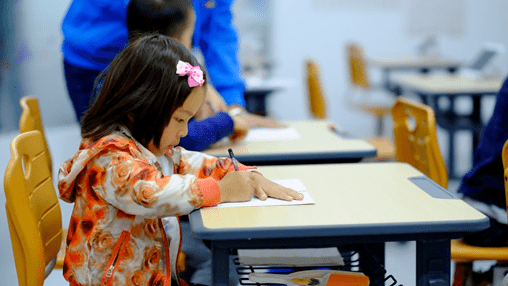Teachers in Training: Train Teachers in the Science of Reading
A growing number of reading teachers are returning to the classroom - or the Zoom room - and assuming the role of student, learning how to revamp their literacy curricula and teaching strategies to meet the needs of their youngest readers. This week, we examine school districts that are working to train teachers in the science of reading, equipping them with data-driven tools and literacy tutors to restore foundational reading skills among all students.
A renewed emphasis on training teachers in reading science has led to major shifts in U.S. school districts: among them, Stanly County School District in North Carolina, where the composite pass rate for all students, defined as a level 3 or above, was 48 percent in 2019, almost 10 percentage points lower than the state average. In 2020, it fell to 37 percent. In response to this decline, the county’s elementary and pre-K teachers will soon complete the Language Essentials for Teachers of Reading and Spelling (LETRS), a state program that provides teachers with research, knowledge, and skills based on the science of reading to achieve literacy among all students, even those with dyslexia and other reading challenges.
LETRS contains eight units of study, each consisting of six to eight sessions, and is taught over the course of two years. During this time, teachers complete a total of 140 to 160 hours of work and learn critical concepts, including the foundational role of phonics in early literacy. Noting the volume of work required to complete LETRS, Stanly schools plan to implement extra time to complete training during staff meetings as well as professional development sessions. The scientific focus of LETRS is not limiting: if anything, educators at Stanley are eager to engage students with non-traditional reading materials and are encouraged to incorporate their unique teaching styles into LETRS-based curriculum, modifying and adapting to meet the needs of individual students and classrooms.

By optimizing teacher training to meet the immediate needs of students, elementary schools hope to ease the journey and increase the long-term success of both students and staff. Making literacy training accessible and applicable for teachers is key to the sustainability of these initiatives. Given federal relief money for extra K-2 supports and virtual literacy interventions, schools such as Rehobeth Elementary in Alabama are employing Title 1 classroom aides and paraprofessionals to work with students in and outside the classroom, in addition to training core teachers in the fundamentals of reading science.

These recent efforts demonstrate the importance of both scheduling and funding to provide adequate support and training for teachers in the science of reading. While the details can be challenging, investing in well-trained teachers is a worthy cause: at Rehobeth, second graders improved their reading scores by 60 points from last fall to spring after boosting staff training and tutoring sessions, according to schoolwide data. Recent research from the National Center for Education Evaluation and Regional Assistance additionally suggests that while literacy interventions work at any grade, introducing interventions and tutoring in kindergarten through second grade is optimal to minimize the developmental and financial costs of reading remediation at higher grade levels. Kymyona Burk, a national reading expert who pioneered a Mississippi-based reading retention program in similar to Rehobeth’s, ultimately urges schools to “invest in people.” This investment includes teacher training and literacy curricula based on the science of reading, utilizing federal COVID aid to listen and respond to the needs of reading teachers, and helping students recover the foundational K-2 literacy skills that will pave the way to lifelong reading.

Take-Aways:
- Stanly County School District in North Carolina and Rehobeth Elementary in Alabama have both implemented plans to train teachers in the science of reading, focusing on foundational skills such as phonemic awareness and decoding.
- In North Carolina, the statewide teacher training program known as LETRS will equip teachers with science-backed strategies to improve reading success among all students, even readers with dyslexia and other learning challenges.
- Prioritizing teachers and literacy tutors trained in the science of reading is key to the long-term success and sustainability of literacy curricula, particularly as classrooms continue to recover skills lost during virtual instruction.
5 Strategies to Train Teachers in the Science of Reading
As the science of reading has progressed, so have the tools for teaching it. Here are some strategies for teachers to use in their classrooms to promote reading and improve student achievement.
Strategies for Teachers
There are many strategies for teachers to use in their classrooms to promote reading and improve student achievement. One way is to use a reading-friendly classroom, which features a positive reading environment. This could include an article on a wall that students are encouraged to read or being given the opportunity to select a book they want to read. Teachers should also incorporate phonics into their lessons by teaching students how letters make different sounds and words can be changed by adding small spelling changes like changing "man" to "men." Repetition is another way teachers can help with reading skills. Students should be exposed to the same material over and over again which will help them remember what they have learned in class. Lastly, educators should encourage children who have difficulty with reading comprehension by teaching them strategies for dealing with difficult texts like summarizing sentences or looking at pictures with captions for additional information about the text.
Strategies for Parents
Although we have many different strategies for teachers, it's important to remember that parents play a large role in the development of their child's reading skills. Here are some ways that parents can help their children with reading:
1. Provide your child with plenty of books and magazines with words they are likely to know
2. Go on daily walks or take car trips to expose them to new words
3. Get involved in your child’s school and encourage other parents to do the same
4. Read aloud to your child every day, even if it doesn't last long
5. Encourage your child to read out loud to you
Strategies for School Leaders
1. Implement a reading culture in your school.
2. Create a supportive environment for reading.
3. Provide access to a wide variety of texts and materials
Implementation Suggestions
1. Teach letter combinations and phonemes.
2. Use multisensory instruction to make the connection between visual and auditory cues.
3. Provide a guided reading experience with a focus on comprehension, not just decoding skills.
4. Use explicit teaching strategies to support struggling readers through reading comprehension exercises that closely align with their needs.
5. Create engaging lessons using high-interest text to keep students engaged in the learning process.
Start Teaching Reading for Free Now!
Access Level 1’s four interactive stories and the accompanying supplemental resources to teach elementary students how to read. No credit card is needed. Join the 42,635 teachers and students using our reading program.
